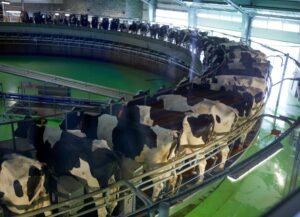Lucas Pantaleon
Endometritis is defined as a process that causes superficial endometrial inflammation with the presence or not of purulent vaginal discharge (PVD) between 21- and 49-days post-partum. PVD in cows during the puerperium has a negative affect on milk production and farm profitability. The delayed ovarian activity caused by PVD leads to greater number of day’s open, longer calving interval and lower conception rate.
A recently published study evaluated the biochemical profile, body condition score and milk production of cows with PVD, as well as its effects on reproductive performance. A biochemical profile could be used as an early diagnosis tool for PVD, which in turn can minimize economic losses in dairy herds.
The study was performed on 3 Brazilian commercial dairies where 338 Holsteins between 3 to 5 years of age were enrolled. Cows were divided in a control group (242 cows) and PVD group (96 cows), blood was collected from both groups at 25 days post-partum. During blood sampling, the body score and milk production were also recorded.
The overall prevalence of PVD in this study was 28.4%. PVD had a significant negative effect on reproductive performance of affected cows. Researchers found that the number of services per pregnancy, days until first insemination, days open and pregnancy loss were higher in the PVD group. The cows in the affected group were less likely to be pregnant at 30 and 60 days after insemination.
Cows with PVD had a lower body score. It is known that dairy cows with a body score less than 3 are more likely to develop clinical disease and cows with greater loss of body condition in the post-partum period are more likely to have fewer pregnancies after insemination and more likely to lose their pregnancy. In this study 72% of cows in the PVD group had a body score less than 3.
Milk production was lower in the affected group of cows compared to healthy cows. Other studies have shown a negative association between uterine disease and milk production.
The biochemical profile in the affected group showed several abnormalities when comparted to the control group. Cholesterol can be a predictor of energy balance status in dairy cows because low cholesterol has been associated with severe loss of body condition. In the study described here PVD cows had a lower cholesterol level compare to control animals. Cholesterol is associated with the production of hormones in the ovaries, thus playing an important role in follicle maturation.
Therefore, low cholesterol concentration in PVD cows can be responsible for impairing reproduction and increasing the time the cow does not ovulate. The liver enzyme GGT was lower in the PVD group, indicating liver injury, which in turn can be a cause for the lower serum cholesterol levels in those cows. Serum calcium was also lower in affected cows, calcium is important for uterine contraction and involution after calving. The lower calcium concertation could be a contributing factor for PVD.
Reference
Paiano, R.B., Goncalves, C.G., Mendes, J.P., Bonilla, J., Birgel, D.B., Birgel Junior, E.H. 2019. Comparative biochemical profiles, production and reproduction status of the post‐partum dairy cows with and without purulent vaginal discharge. Reproduction in Domestic Animals. 54(9): 1188-1194.
© 2020 Dairy Knowledge Center, LLC. All Rights Reserved.











